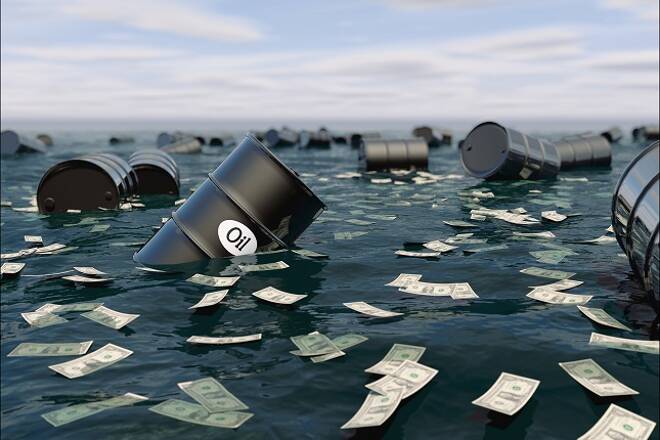Advertisement
Advertisement
Oil Price Fundamental Weekly Forecast – IEA, OPEC Dire Demand Predictions Offset Bullish EIA Production Drop
By:
With both essential components of oil consumption continuing to struggle in the wake of the pandemic, it’s hard to build a case for higher prices.
U.S. West Texas Intermediate and international-benchmark Brent crude oil futures settled higher last week, but the increase was a little deceiving. The extremely tight trading range suggests a lack of bullish conviction despite the rally. Furthermore, the markets traded inside the previous week’s range, hardly a bullish sign. Typically, an inside move indicates investor indecision.
The gains were basically produced in one day when a surprise 300,000 barrel drop in weekly production triggered a strong rally. Most of the week, however, the market traded in a range on low volume.
Last week, October WTI crude oil futures settled at $42.31, up $0.82 or +1.98% and December Brent crude oil finished at $45.77, up $0.66% or +1.44%.
Weekly Recap
With both essential components of oil consumption continuing to struggle in the wake of the pandemic, it’s hard to build a case for an upside breakout. Even bullish news about a drop in U.S. production wasn’t enough to take out WTI’s previous week’s high at $43.68 and Brent’s previous week’s high at $46.87.
The markets were essentially flat early in the week but surged to their highs of the week on Wednesday in the wake of bullish data from the U.S. government. However, the market edged lower on Friday, giving up some of the week’s gains. Prices were likely capped by doubts about demand recovery due to the COVID-19 pandemic and rising supply.
Although the futures contracts were hovering near the high of their two-month trading ranges and slightly above a long-term 50% level, bullish traders are having a hard time extending the rally because of lingering demand concerns.
Fundamentally, crude oil was boosted this week by U.S. government data showing crude oil, gasoline and distillate inventories all declined the week-ending August 7, but gains were limited because the global oil supply is rising due to OPEC and its allies increasing output this month.
US Energy Information Administration Weekly Inventories Report
In its weekly report, the U.S. Energy Information Administration (EIA) reported that U.S. crude oil, gasoline and distillate inventories fell last week as crude production dropped sharply and refiners ramped up production.
The most supportive news in the EIA report was the drop in U.S. crude output to 10.7 million barrels per day from 11 million bpd in the previous week.
OPEC Trims 2020 Oil Demand, Raises Questions about 2021 Due to Virus Fallout
World oil demand will fall more steeply in 2020 than previously forecast due to the coronavirus and there are doubts about next year’s recovery, OPEC forecast on Wednesday, potentially making it harder for the group and its allies to support the market, Reuters reported.
World oil demand will tumble by 9.06 million barrels per day (bpd) this year, OPEC said in a monthly report, more than the 8.95 bpd decline expected a month ago.
IEA Sees Lower Oil Demand in 2020, 2021
The International Energy Agency (IEA) lowered its global oil forecasts for the first time in several months on Thursday, as the number of COVID-19 infections remains high and amid ongoing weakness in the aviation sector.
The IEA said it now sees global oil demand for 2020 at 91.1 million bpd, reflecting a fall of 8.1 million bpd day year-on-year. The revised forecast is 140,000 bpd lower than the IEA’s previous projection.
Weekly Forecast
Although the U.S. cut production, OPEC+ is gradually raising output, which is helping to increase global supply so the EIA production-drop news isn’t as bullish as first thought. Furthermore, the ongoing uncertainty around demand caused by the COVID-19 pandemic and the possibility of higher global output could keep a lid on prices.
The inability of Congress to reach an agreement on additional stimulus measures could weigh on prices this week because the news has the potential to negatively affect demand. U.S. policymakers are not expected to revisit the issue until after September 7 when they return from their summer recess. An emergency meeting could be called but as of the weekend, it wasn’t being discussed.
Economic data last week was supportive for crude oil, but the numbers from July reflected an economy that was being supported by government aid. The longer the economy goes without additional stimulus, the worse the numbers could be for August. This concern could weigh on demand and prices this week.
Keep in mind that the U.S. summer driving season is quickly coming to an end. This puts further emphasis on U.S. gasoline supplies.
About the Author
James Hyerczykauthor
James is a Florida-based technical analyst, market researcher, educator and trader with 35+ years of experience. He is an expert in the area of patterns, price and time analysis as it applies to futures, Forex, and stocks.
Did you find this article useful?
Latest news and analysis
Advertisement
